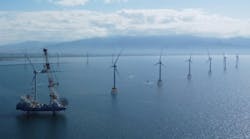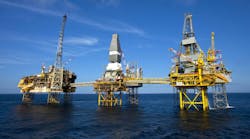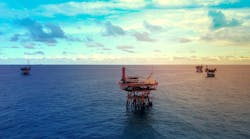European consumers have a large appetite for clean-burning natural gas. Coal-fired plants are not in favor, due to problems with air quality control; nuclear power in Western Europe is on the decline, a result of the Chernobyl accident. Germany, for example, proposes to wind down nuclear power over the next five years.
European power plants draw heavily from gas reserves in the former Soviet Union as well as gas flowing north from Algeria across the Straits of Gibraltar in subsea pipelines. Vanco's assessment is that there continues to be a viable European market for future natural gas reserves utilized for power generation and industrial sectors.
Vanco Energy Company (Houston), an aggressive international independent exploration company, has acquired substantial acreage in deepwater off West Africa, including large positions in Gabon, Côte d'Ivoire, Equatorial Guinea, Senegal, and Morocco. Specifically, Vanco acquired an acreage position of 7.4 million acres off Morocco in deepwater - 4.6 million gross acres in the Safi Haute Mer Block and 2.8 million acres in the Ras Tafelney Block.
In Senegal, Vanco acquired the 7.9-million-acre Dakar Offshore Profond Block. Both of these blocks are in deepwater Morocco and Senegal, and show potential for major gas reserves. Two-dimensional seismic reveals substantial structures, which appear to be gas prone.
Market proximity
Major gas reserves offshore Morocco and Senegal are possible candidates for sale to the European marketplace. Associated natural gas production offshore West Africa has traditionally been flared, rather than sent to market or utilized in some other manner. Flaring has long been considered a waste of West Africa's growing natural gas resources.
Vanco is evaluating the technical and economic feasibility of bringing Northwest African gas to European markets via an offshore pipeline. A possible first phase would be to take Moroccan gas to Europe, followed by moving gas reserves northward from Senegal. Vanco is evaluating the possibility of laying an offshore gas pipeline from Senegal to Morocco, and then on to Spain, in order to tie into the network of natural gas pipeline distribution systems across the Western European continent.
Such a transportation project would require construction of an offshore pipeline from Senegal, along the coast of West Africa to Morocco, crossing the Straits of Gibraltar, and into Spain. En route, the pipeline would be on the shelf and follow the coastlines of Senegal, Mauritania, Western Sahara, and Morocco.
Gas prospectivity
Future planning for such a pipeline venture is predicated on discovering and establishing gas reserves offshore Senegal, Morocco, and other West African countries. Vanco has commissioned extensive seismic surveys in these areas.
The seismic interpretation is quite promising, showing large potential gas reserves offshore Northwest Africa. Vanco initially approached offshore West African deepwater acreage with the primary thought of oil production. Given the substantial potential for gas reserves in the region, management is considering the commerciality of delivering gas north to hungry European markets. Two major benefits would be the revenue generation to each of the host countries and the delivery of clean-burning natural gas to the European market.
A preliminary pipeline design study has been made, with the objective of confirming the feasibility of routing a pipeline from Senegal to Spain, using data available in the public domain. Conceptual pipeline sizing calculations have been performed and approximate cost estimates have been completed.
The pipeline design study was undertaken by Intec Engineering (Houston). Intec identified areas of particular concern in the pipeline route. Based on an evaluation of available data, it is concluded that a shallow water pipeline route along the coast of Africa from north of Fosse de Cayar, Senegal up to Morocco is feasible. Water depths along the route are in the range of 50-100 meters.
Pipeline routing
The pipeline route would pass through short sections of territorial waters that are within the 12-mile limit offshore Senegal and Morocco, where the potential gas reserves are located. The pipeline route is easily accessed by conventional pipelay barges. Features that will need to be considered during the design and construction of the pipeline include irregular seabed conditions such as canyons, communication cable crossings, fishing activity, and third party oil and gas exploration.
The feasibility of a deepwater pipeline route from Morocco north to Spain is inferred, based on the fact that a pipeline system has been already constructed across the Straits of Gibraltar in water depths exceeding 400 meters.
Pipeline sizes under consideration include 36 in., 42 in., and 48 in. diameter trunk lines. Installation of the pipeline is feasible using presently available technology and installation vessels.
The establishment of a suitable logistics system to support lay barges, and particularly the uninterrupted supply of line pipe, would be the most critical installation activity during the project. Several existing ports would likely require upgrade and investment to meet pipe supply requirements.
Capacity questions
The line pipe diameters under consideration are within manufacturing capability of existing pipe mills. However, no single mill would have the capacity to supply several pipelay barges installing the pipeline simultaneously.
The total length of a pipeline from Dakar, Senegal to Gibraltar would be about 2,890 km. It would require several large offshore pipelay barge spreads, working simultaneously on different sections of the pipeline in order to make completion in a timely manner. Furthermore, it is likely the project requirements would take up worldwide pipe mill capacity, which might result in delays to the schedule and higher prices to the market.
The pipeline would include offshore compressor stations spaced approximately 500 km apart. In the Straits of Gibraltar area, the pipeline route would follow that of the existing European Maghreb Pipelines Limited pipeline from Algeria. Natural and man-made obstructions or hazards indicated on navigation charts would be avoided. Examples of hazards include shipwrecks, oil and gas infrastructure, subsea communications cables, and subsea geo-hazards such as rocky bottoms and canyons.
Seabed topography
Western Africa is a stable geological block. Regional seismicity is low, and it is not expected to be a hazard to the pipeline. Pipelines have been constructed across the Straits of Gibraltar, which represents the boundary between the African and Eurasian continental plates and is the most active site in the region.
Also, there are significant currents within the Straits as the waters of the cool Atlantic Ocean mix with the warm waters of the Mediterranean Sea. The Moroccan coastline to the north of Cape Tarfaya is generally mountainous, particularly between Cape Hadid and Cape Rhir. Between Cape Rhir and Sidi Ifni, there appears to be a relict canyon formed by ancient rivers.
Cape Blanc Mauritania appears to be a relict delta, with shoals extending offshore to the continental shelf break. In the vicinity of these shoals and offshore from the mountainous coastline, the continental shelf is often narrow, with an abrupt shelf break and steep continental slope which restricts routing options.
In places, the continental shelf is incised by canyons - for example, the two canyons to the west of the Senegal River and the dramatic Senegal Fosse de Cayar immediately to the north of Dakar.
The last low stand was 10,000-15,000 years ago. The sedimentary environment has been relatively quiet since then. The irregular and potentially unstable seabed associated with canyons would have to be considered during survey design and construction.
The predominate concentration of shipping along the pipeline route is in the Straits of Gibraltar. The relevance of this to the pipeline is considered to be negligible, as this is a deepwater crossing and the surface currents are extremely high and anchoring would not be anticipated. Numerous ports, the busiest being Casablanca, Agadir, and Safi - all in Morocco - exist along the proposed pipeline route. As the route is parallel to the coast, crossing of the pipeline by shipping traffic would be unavoidable given the activity in the ports.
The risk of damage to the pipeline from shipping would need to be considered in the design. Based on the latest British Admiralty charts, the pipeline route near Casablanca, Morocco would cross four submarine cables. In all cases, the pipeline route would cross cables almost at right angles, which is most desirable for pipeline installation purposes. In addition, the water depths in which crossings occur are suitable for conventional cable crossing construction using concrete mattresses.
In the Straits of Gibraltar, the pipeline would cross an additional four communication cables. These cables have been crossed successfully during construction by existing pipelines. The pipeline would be of suitable design to be laid by conventional large offshore pipelay vessels.
The steel pipeline would be coated with thin film epoxy and concrete heavyweight coating, with anodes placed at appropriate intervals. Installation of the pipeline in 50-100 meters water depth is ideally suited to existing S-lay pipelay barges. It is assumed that installation would be performed by at least three separate laybarge spreads.




